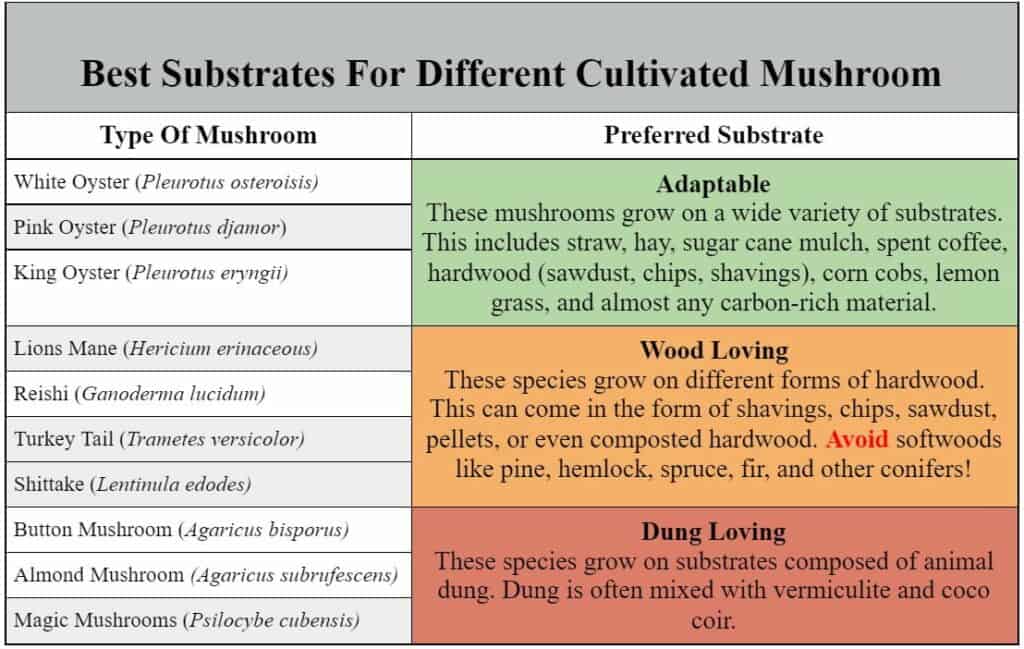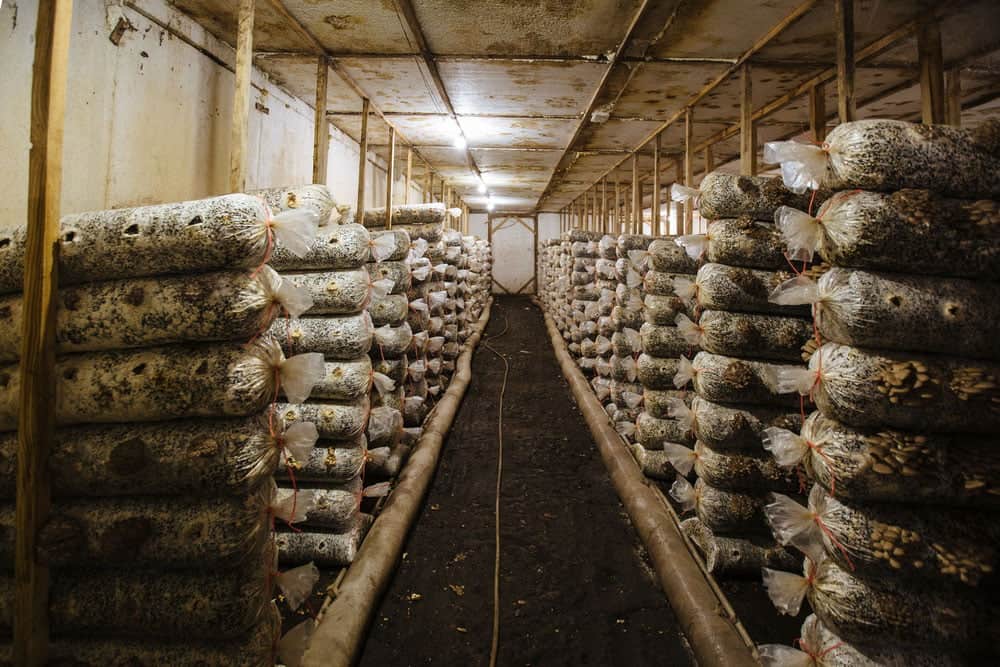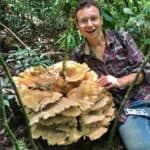Table of Contents
Mushroom substrates are a fundamental part of mushroom cultivation. They are the food and habitat for your fungal mycelium. They must be well-chosen and prepared for a successful yield.
In this article, we will cover everything you need to know about mushroom substrates. What you need to know, to start growing your own mushrooms!
Food For Thought
Mushrooms are not plants. They have to eat. In this sense, they’re no different from us. In other ways, they are magnificently unique organisms.
The peculiar thing about mushrooms is that they not only consume their food, but they also live within it! They colonize their food source, breaking it down with digestive enzymes. Thus their food source needs to be nutritious and also conducive for healthy growth.
Related: What do Mushrooms eat?
Mushroom Substrate = Mushroom Food and Habitat
Mushroom substrates are the most important materials used for cultivating mushrooms. They serve as your mushroom’s growth medium, food source, and habitat. They’re made from a wide quantity of different materials.
Mushroom Substrates must Provide:
- A Food Source
Mushroom substrates are the food for your mushroom. They must provide all the minerals, nutrients, and energy-rich compounds needed for growth. - Environmental Conditions
Substrates also provide the living environment for mushroom mycellium. They should provide have the right physical and chemical properties needed for growth. Physical structure promotes the porosity, moisture level, and air exchange needed for growth. Chemical properties include pH and compounds that may interfere with growth. - Clean Growing Environment
Substrates need to be free of harmful microorganisms. These will contaminate and affect your mycellium. For this reason, substrates are usually pasteurized or sterilized.
Most common Mushroom Substrates
- Straw
- Hay
- Wood Chips
- Wood Shavings
- Wood Burning Pellets
- Coffee
- Saw Dust
- Agricultural waste
Choosing the RIGHT Substrate
Choosing the right substrate may seem difficult at first. There are hundreds of different resources you can use. In reality, the best substrate largely depends on two things. The mushroom you are growing and what type of resources you have readily available in the area.
Your Substrate should be:
- Adequate For The Mushroom Variety You Are Growing
- Affordable
- Free or Toxins or Pollution
- Easily Available
- Easy to Work With
- Require Minimal Processing
Best Substrate for different Mushroom Varieties
Different types of mushrooms need different types of substrates for growth. Some mushrooms, like the famous Oyster Mushroom, can eat almost anything you feed them! Some require very specific diets.

Growing Mushrooms on Straw
Straw is one of the most used substrates for mushroom cultivation. It is affordable, easy to handle, and accessible. There are many types of straw, so it is important to consider when purchasing.
Straw Substrate works for:
- Common Oyster
- Pink Oyster
- King Oyster
- Other varieties of Oyster Mushrooms
Pros and Cons of Straw Substrate
Pros
- Cheap
- Accessible
- Low Environmental Foot Print
- Works well with all oyster varieties
- Stores well under proper conditions
Cons
- Requires processing
- It may not be organic
- A bit messy
- May vary in quality
- Difficult to transport
Things to consider with Straw Substrates
- Different Types of Straw – There are many types of straw to choose from. Wheat and Oat are the most recommended. Rice straw is also a good option. Nutrient-dense straws such as pea straw are less recommended. Avoid hay.
- Finding Organic Straw – Straw is not always organic. If you worry about pesticides and agrochemicals look for organic straws.
- Cleaning Your Straw – Straw is often dirty. Most growers don’t do it, but if your experiencing troubles, consider rinsing your straw.
- Chopping Your Straw – You want your straw to be in pieces about 3” in length. While you can do this by hand with a machete or other hand tools, it is easily done with a weed whacker. An easy way to do this is by placing your straw in a large barrel and running your weed whacker inside it!
- Straw Gets Everywhere – It can be messy! So be ready to prepare your workspace adequately!
- Unsupplemented Straw Doesn’t Need Sterilization – It only requires pasteurization.
Growing Mushrooms on Wood Substrate
- Hardwood is one of the most prized materials in mushroom cultivation. You can practically grow most gourmet edible and medicinal mushrooms on hardwood substrates. Hardwood substrates come in many forms.
- Sawdust is an incredible substrate. It is useful for many types of mushrooms.
- Wood shavings are not as good as sawdust. Some growers age this material until it is more broken down.
- Wood chips are not the best material. They are too large. Growers may age these until they become well decomposed.
Wood Pellets are sawdust compressed into pellets. These are available for wood-burning stoves and standardized. They are not very expensive, but usually more than a direct source of sawdust. Look for pellets with no glues or chemicals.
Pros and Cons of Wood Substrates
Pros
- Grow almost any gourmet and medicinal mushroom variety.
- Produces good yield improved via supplementation
- Usually organic
- Requires little processing
Cons
- May be hard to get pure hardwood.
- Mixed results with different types of hardwood.
- Avoid contaminated substrates with oil from saw/machinery.
Things to consider with Wood Substrates
- Always make sure you get pure hardwood materials. This includes oak, beech, maple, sycamore, alder, apple, almond, and other orchard trees. Coniferous trees like pine, spruce, cypress, and fir DO NOT perform well.
- For best results, you want to use sawdust or a decomposed aged woody material.
- Large chips may work for oysters and other vigorous varieties.
- Supplement your sawdust to increase yield. It is usually supplemented with bran or soil hull. Supplemented substrates will need sterilization.
Supplementing Saw Dust
Some of the most used and esteemed substrate recipes are from supplemented sawdust. This is a nutrient-rich material that is added to the substrate to increase the yield.
- One of the most common recipes is adding about 5-10% bran to your substrate.
- The “Masters Mix” for Oysters includes 50% soy hulls and 50% hardwood sawdust.
The downside about supplementation is that the excess nutrients mean it requires sterilization!
Growing on Manure Substrates
Nature wastes nothing. One animal’s waste is another organism’s feast. Certain mushrooms in particular love growing on animal feces. This includes the button mushroom and portobello. Magic mushrooms are also cultivated on animal dung.
Consideration when using Manure Substrates
There are many different types of manure. They can originate from different animals with different diets. They can also be at different stages in decomposition.
- Composted Manure is your best bet.
- Fresh Manure is not ideal but work. Horse manure and those with less nitrogen are best. Chicken manure and other nitrogen-rich substrates are not suitable without composting. If you don’t want to compost it, drying it in the sun will make it easier to work with.
- Manure is only useful for growing Agaricus and Psilocybe species.
- Bedding from works after composting. Avoid materials with cigarette butts or other garbage.
- You may have mixed results with the same type of manure depending on what the animal has been consuming!
- Agaricus species need a casing layer. This consists of 50% vermiculite and 50% coco coir.
Pros and Cons of Manure Substrates
Pros
- The best option for Button Mushrooms and other Agaricus species
- Works for Psilocybe species
- Can be inexpensive or free
Cons
- Doesn’t work for most gourmet and medicinal mushrooms.
- Can be messy
- Usually requires composting
- Needs caution when handling
- May need other materials
Other locally available Substrates
Some of the most common forms of substrate used by growers are byproducts. Usually from the agricultural, woodworking, and food processing industries. These may be cheap or even free!
Using Waste Resource
- Wood Waste – Ask a local carpenter about wood shaving or sawdust they may have. Most people are willing to give it away for free as long as your pack it out! Make sure to ask the type of wood they are using.
- Agricultural Waste – Corn stalks, peanut shells, and other waste products are excellent substrates. Tough woody materials are best.
- Food Waste – Coffee grounds, spent brewery grain, and food waste can work.
- Garden Waste – Tree trimming companies often produce large quantities of wood chips. If they don’t already have someone who asked them for it, they may be happy to drop it off at your home!
Pasteurization vs Sterilisation
Once you’ve figured out your substrate of choice you now need to make it suitable for fungal growth. To do this, you will have to remove most or all microorganisms living on your substrate. This is what pasteurization and sterilization are for. These are processes that remove microscopic life from your substrate.
Why do you need to Pasteurize or Sterilise Mushroom Substrate?
- Microorganisms will compete with your mycellium for the substrate. They may produce anti-fungal compounds and make the substrate inaccessible.
- Microorganisms can contaminate and infect your mushroom mycellium. Specific antagonists like Trichoderma and Pennicilum are common reasons cultivation fails.
What’s the difference between Pasteurisation and Sterilisation?
Pasteurization aims to remove most microscopic life. Sterilization aims to remove ALL microscopic life.
Differences between Pasteurisation and Sterilisation
Pasteurization
- Less intensive
- Only removes MOST of all microorganisms on the substrate.
- Work well with unsupplemented substrates.
- Is done with hot water baths, lime baths, and many other ways.
- Particularly useful for the cultivation of Oysters on straw
- Doesn’t work with the supplemented substrate
- Doesn’t work with pickier mushroom species
- Is done by submerging in water at 160-170 degrees F for 1 hour.
Sterilization
- More intensive
- Needs high heat and pressure
- Aims to remove ALL microscopic life
- Done within pressure cookers or autoclaves
- Necessary for supplemented and nutrient-rich substrates
- Requires grow bags, jars, or vessels that can withstand high heat and pressure.
- Needed for the production of spawn, liquid cultures, and Petri dishes.
- Requires around 90 minutes at 15 psi inside a pressure cooker.

